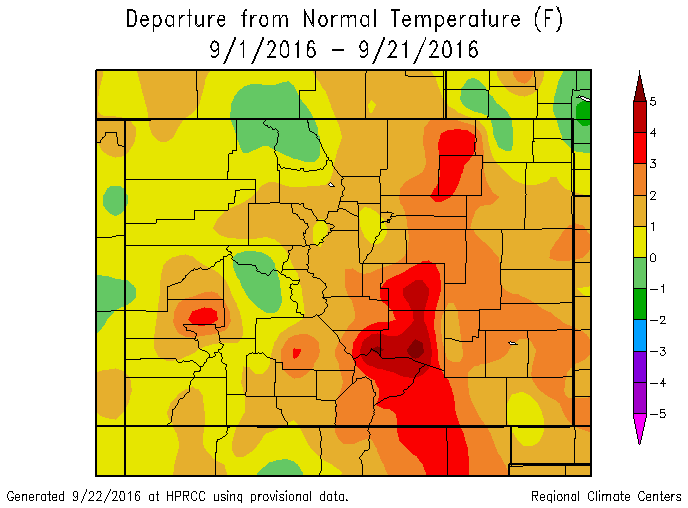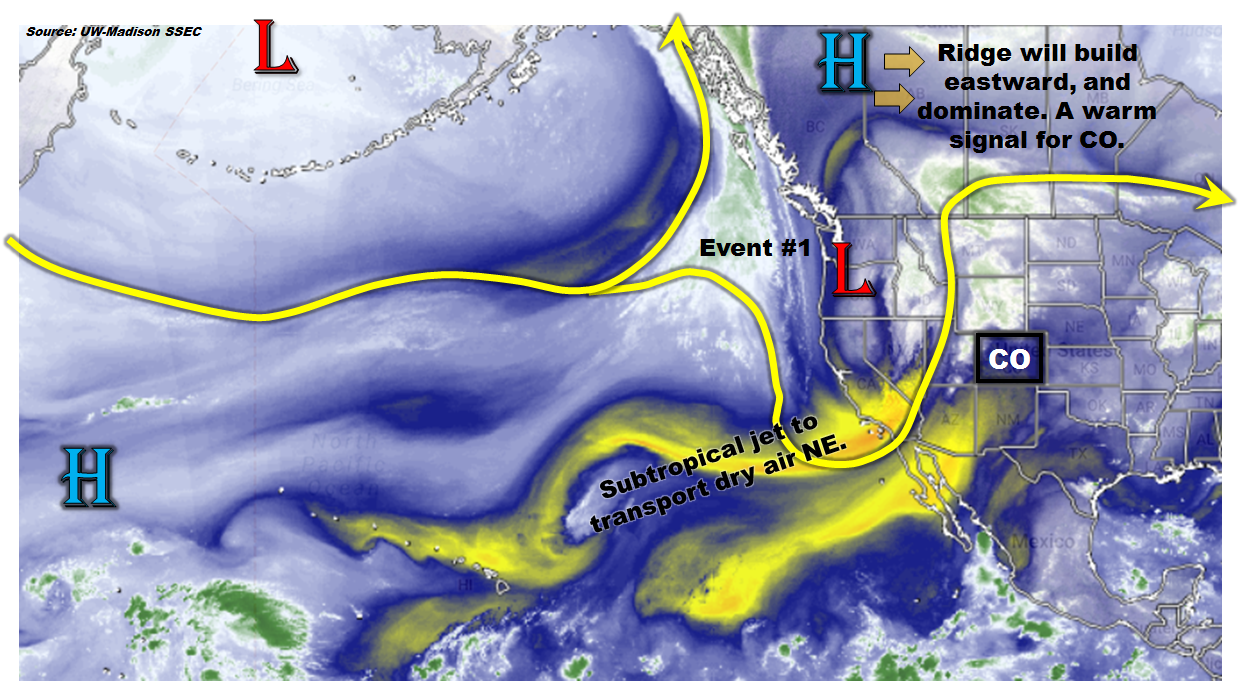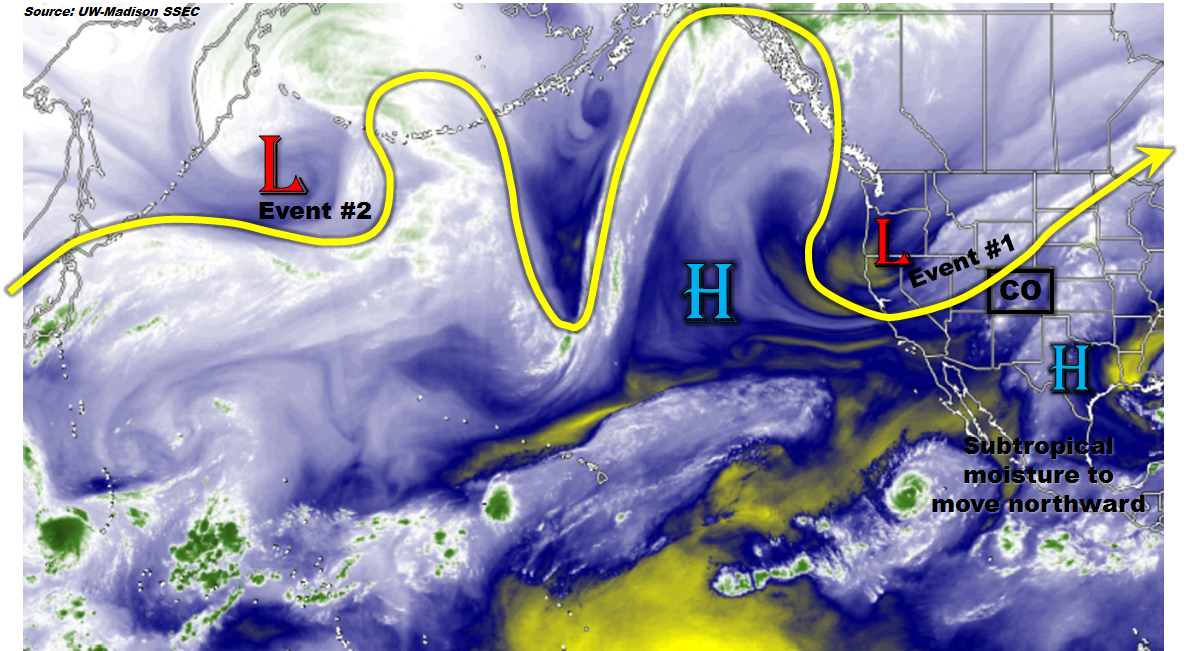Issue Date: Thursday, September 22nd, 2016
Issue Time: 1:30PM MDT
Valid Dates: September 23rd trough October 7th
It has been a warm September for Colorado, with average temperatures running up to 4 F above normal east of the Continental Divide (see map below). Accompanying the warmth has been a lack of rainfall basically statewide. Fortunately, September is not a particularly important month from the standpoint of water supply since average precipitation in valley locations begins to decrease from its summer peak. Meanwhile, higher elevation precipitation does not really begin in earnest until October as the jet stream intensifies and moves south, providing a steady stream of moist Pacific air that hits our mountain ranges and condenses.
As the water vapor image shows, below, apart from an early event that will yield light to moderate rainfall amounts mainly over the higher terrain west of the Divide, the rest of September is likely to follow what we have seen up to now: dry and warm. This will be courtesy of a sprawling upper-level ridge that is seen on the water vapor image.
The high-pressure feature will move eastward and intensify, the net effect being a clockwise circulation that will promote southerly warm air to impinge on Colorado. In concert with this, as the current upper-level trough moves eastward, it will transport dry (perhaps very dry) air from the subtropical eastern Pacific Ocean. This will set the stage for a multi-day period of very warm temperatures, up to 15F above normal accompanied by relatively low moisture content later next week. Some readers may have already made the connection: there is likely to be an elevated wildfire threat. The most likely areas to experience the anomalous warmth and heat will be east of the Continental Divide. However, the entire state is expected to average normal to above normal, temperature wise, over the 15-day period covered by this Flood Threat Outlook. One minor exception to this rule could be late next week (9/30-10/2) when a new upper-level trough will likely enter the west coast. There are some indications that a moderate amount of subtropical moisture could be drawn into this trough, resulting in a round of showers and maybe a few storms west of the Divide (Event #2). However, at this time, it will be surprising if this can generate widespread rainfall exceeding 0.5 inches. Thus, both Events are designated as No Apparent Flood Threat.
Overall, today’s analog anomalies centered on October 3rd provide an excellent summary of what we can expect over the next 15 days. Note the 500-mb height ridge position by that time moves into eastern North America, while a weak semi-stationary trough holds firm over the Pacific northwest. On the low-level temperature map (we are using the 925-mb level), note the very strong warm anomalies over the Great Plains, including eastern Colorado.
Below we describe the details of the two Events.
Event #1: Friday (9/23) and Saturday (9/24)
No Apparent Flood Threat as trough moves across Colorado
The large-scale trough that is currently affecting western Colorado will move across the state on Friday and Saturday. Despite the seemingly high moisture levels, most of this moisture is being held well above the boundary layer. Nonetheless, several rounds of showers and perhaps a weak thunderstorm will race across the state on Friday, mainly limited to the higher terrain. Up to 0.75 inches of rainfall will be possible over isolated locations, but flooding is not expected as this precipitation will be spread out over several hours. Rainfall amounts will decrease further on Saturday with up to 0.5 inches possible over isolated locations of northern and eastern Colorado.
As the trough moves overhead by late Friday, it will be accompanied by a 48-hour period of much cooler weather with snow levels coming down to 9,500 feet. However, accumulating snow will be hit-or-miss and only a few inches, at most, are expected in any given location. The one exception to this will be the San Juans where perhaps up to 6 inches could fall. Overall, this event is likely to be known more for its winds, which could gust up to 70 mph over the higher terrain, than its precipitation.
Event #2: Saturday (10/1)
No Apparent Flood Threat as another trough approaches Colorado
After Event #1, dry and very warm weather will return across Colorado (especially eastern areas). The next weather feature will be another large-scale trough (identified as Event #2 in Brad’s previous post) that is forecast to enter the west coast late next week. At this time, it does not appear that this trough will have enough moisture to deliver much rainfall across the state. Instead, it could be another wind event much like Event #1. The only caveat is the potential entrainment of subtropical air courtesy of a recurving tropical storm. Many things will have to come together for this to happen, and the most probable outcome at this time appears to be a light rainfall event (less than 0.5 inches; hence no precipitation map). Worst-case scenario, this could turn into a low-end flood threat for southwest Colorado should enough subtropical moisture get involved. Stay tuned to Monday’s updated Outlook.










